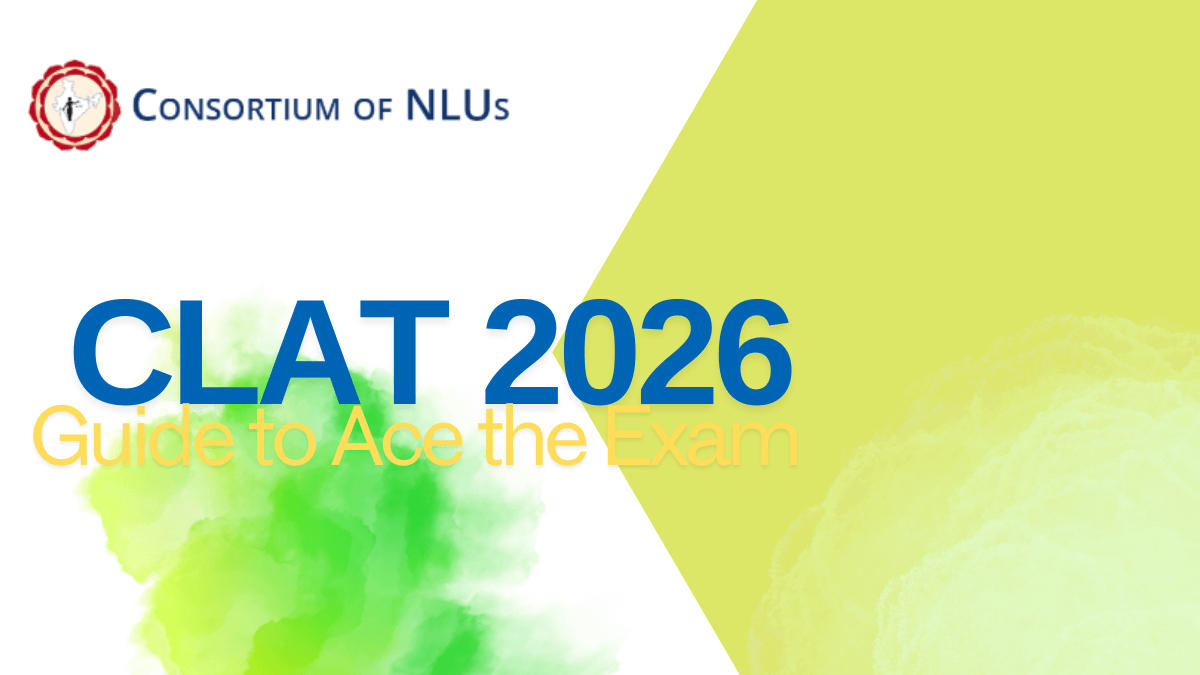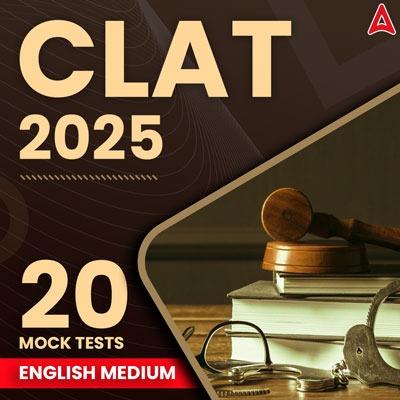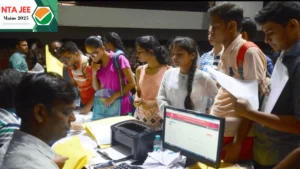Table of Contents
If you are planning to choose Law as a career and going to take the CLAT 2026 Exam, all you need to read this full post line by line to gather all the useful information about the exam. At the beginning of the CLAT Preparation 2026 the first thing aspirants search for is the right guidance who can tell everything about the entrance test. It can be anything an online blog, a teacher, CLAT coaching, your senior, or your peers. Let’s first learn about the CLAT exam pattern, subjects, syllabus, and upcoming CLAT exam dates; Then how you should make proper strategies to crack the exam and more.
CLAT 2026
Common Law Admission Test or CLAT 2026 is a National level entrance exam where meritorious students get a chance to complete their law degrees from 25 prestigious National Law Universities (NLUs). Students who have completed their 10+2 level can sit for this entrance test. CLAT paper is basically divided into 5 sections – English Comprehension, Legal Reasoning, Current Affairs, Logical Reasoning, and Quantitative Techniques. The exam will be conducted offline.
CLAT 2026: Overview
CLAT UG scores are also accepted in other top private law universities for admission other than the NLUs. There is also an exam called CLAT PG for admission to the LLM programmes. Let’s take a quick tour of the key highlights of the CLAT 2026 Exam in the table below.
| Particulars | Details |
| Name of the Examination | Common Law Admission Test 2025 |
| Exam Conducting Body |
Consortium of National Law University
|
| Frequency | Once a year |
| Total NLUs Participating | 25 |
| Level |
National-level exam
|
| Purpose of CLAT UG and PG Exam |
Admission to LLB and LLM courses
|
| Eligibility |
CLAT UG – 10+2 Class
CLAT PG – LLB Degree
|
| CLAT 2026 Exam Date |
Fisrt Week of December 2025 (Expected)
|
| Mode of Exam |
Pen-and-paper (offline)
|
| Application Mode | Online |
| Application Fee |
General/OBC – INR 4,000
Reserved – INR 3,500
|
| Total Questions | 120 |
| Duration of Exam |
2 hours
|
| Marking Scheme | Correct Answer = +1 mark for each
Wrong Answer = -0.25 for each |
| Official Website |
consortiumofnlus.ac.in
|
CLAT 2026 Exam Date
CLAT Exam for the year 2025 is expected to be held in the first week of December 2025 in pen and paper mode. However, the CLAT Exam Date 2026 will be released by the Consortium of NLUs in the month of September-October 2024 on its portal i.e consortiumofnlus.ac. The early announcement of the CLAT exam date enables law aspirants to have ample time to prepare for the exam effectively. once the exact official CLAT exam date 2026 are announced, we will update the table below-
CLAT Exam Date 2026: Important Dates
Candidates must remember these CLAT exam dates are expected, the confirmed official dates are yet to be announced.
| Event |
Date (Tentative)
|
| CLAT Notification 2026 Release Date | July 2025 |
| When to Register for CLAT 2026? | Third Week of July 2025 |
| Last Date to Register for CLAT 2026 | October 2025 |
| CLAT 2026 Admit Card Release Date | November 2025 |
| CLAT 2026 Exam Date | December 1, 2025 |
| CLAT 2026 Answer Key Releases on | December 2025 |
| CLAT 2026 Result Releases | December 2025 |
| CLAT 2026 Counselling Starting Date |
December 2025 /January 2026
|
CLAT 2026 Application Form
The CLAT 2026 application form will be open tentatively in the Third week of July 2025. The CLAT 2025 exam can be registered online at the consortium’s official website, consortiumofnlus.ac.in. Eligible students must complete the registration process and submit the application by the deadline, paying the prescribed price.
CLAT 2026 Application Fee
The CLAT registration cost is –
| Application Fees for CLAT 2026 |
|
CLAT 2026 Eligibility Criteria
Meeting the CLAT 2025 eligibility criteria is the first step in getting into one of the national law schools. The recent eligibility criteria will be provided soon by the exam authority, along with a notification. The CLAT exam eligibility requirements for undergraduate (UG) and postgraduate (PG) courses are discussed below.
Eligibility for CLAT UG 2026
- To be eligible for CLAT UG, candidates must have completed their 10+2 or equivalent exam from a recognized board.
- General and OBC applicants must have a minimum of 45% marks in 12th grade and SC/ST candidates must score at least 40%
- There is no upper age limit for taking the CLAT exam. Candidates of any age who meet the educational requirements may apply for the examination.
- Candidates who are taking their Class 12th exams in 2026 can apply for CLAT if they satisfy the minimal mark criteria based on the results.
Eligibility for CLAT PG 2026
- For General and OBC candidates, an LL.B. or equivalent degree with a minimum of 50% is required and SC/ST candidates must score at least 45%.
| Also Read |
| What is the difference between CLAT vs AILET Exam? |
How to Fill CLAT 2025 Application Form?
The application window for CLAT 2026 will be in July 2025. Once the application window opens, simply follow the steps to successfully complete the CLAT 2026 Registration via the Consortium of NLUs’ official website. Below is a step-by-step instruction on how to apply for the CLAT 2026 exam.
- Visit the CNLU official website.
Go to the Consortium of NLUs’ official webpage at consortiumofnlus.ac.in. - Registration Yourself
Click the ‘Register’ button. Enter your name, mobile number, and email address, then create a password. An OTP will be issued to your registered mobile number. To complete the registration, please verify the OTP. - Fill out the CLAT application form
Log in with your credentials and provide your personal, academic, and contact information. Select chosen test centers that are most convenient for you. - Upload Required documents
Upload the appropriate papers, including a passport-sized photograph, signature, and category certificate, in the format requested. - Select NLU preferences
You will be asked to select the order of your preferred NLUs based on where you want to study. - Pay the CLAT application fee
Pay your Registration fees online using a debit/credit card, net banking, or UPI. - Submit the CLAT 2026 form
Review your application, make sure all of the information is right, and then submit the form. - Download the Confirmation Page
After successful submission, bookmark the confirmation page for future reference.
Apply for CLAT 2026
After the announcement of the CLAT application form, we will provide the direct link to complete the registration link in the box provided below.
| Apply Online for the CLAT 2026 Exam |
| Direct CLAT 2026 Application Form Link |
CLAT 2026 Registration Last Date
The registration process for CLAT 2026 is expected to begin in July 2025 and close by the last week of October 2025, around October 22, 2025. These dates are tentative and based on the typical timeline followed for CLAT registrations. For exact dates and updates, you should check the official Consortium of NLUs website closer to the release.
CLAT 2026 Exam Pattern
The CLAT UG exam 2026 will test your knowledge in 5 components. They have to answer 120 questions in 120 minutes. The number of questions is reduced from 150 last year. Every year the CNLUs release the CLAT exam pattern and make a few changes. Read the latest exam pattern provided by officials below –
| CLAT UG Exam Pattern 2025 | |
| Total Questions | 120 |
| Duration | 2 hours |
| Type of questions | Multiple-choice questions (MCQs) |
| Total Sections |
|
|
Marking Scheme
|
|
| Correct Answer | 1 mark for each correct answer |
| Incorrect Answer | – 0.25 Marks |
| Unanswered/ Un-attempted Question | 0 Mark |
| CLAT UG 2026 Section-Wise Weightage | ||
| Section | Percentage Weightage (Approx.) |
Number of Questions
|
| English Language | 20% | 22-26 |
| Current Affairs including General Knowledge | 25% | 28-32 |
| Legal Reasoning | 25% | 28-32 |
| Logical Reasoning | 20% | 22-26 |
| Quantitative Techniques | 10% | 10-14 |
| Also Read | |
| All About CLAT Exam Pattern 2026 | How to Score 100+ in CLAT: Proven Tips |
CLAT PG Exam Pattern
Understanding the CLAT PG exam pattern can provide important insights into how the Consortium evaluates candidates. The exam contained both objective and subjective assessments.
The objective portion included multiple-choice questions, each worth one mark. Here’s an overview of how the exam was structured in previous years –
| CLAT PG Exam Pattern 2026 | |
| Exam mode | Offline |
| Duration |
120 minutes /2 hours
|
| Medium | English |
| Type of questions | Objective |
| Subjects |
Different law subjects
|
| Total Questions | 120 |
| Total marks | 120 |
| Marking Scheme | |
| Correct Answer | 1 Mark |
| Negative Marking | -0.25 will be deducted for each wrong answer |
| Unanswered /Unattempted | 0 Marks |
| CLAT PG Exam Pattern 2026: Subject-Wise Weightage | ||
| Section | Subjects |
weightage in (%)
|
| Section 1 | Constitutional Law | 60 |
| Section 2 | Other Law Subjects such as Contract, Torts, Criminal Law, International Law, IPR, and Jurisprudence | 60 |
| Total | 120 | |
CLAT 2026 Syllabus
The Consortium of NLU will release the CLAT 2026 syllabus, along with the Notification. CLAT Syllabus includes five sections: English Language, Legal Reasoning, Current Affairs (including General Knowledge), Logical Reasoning, and Quantitative Techniques. The Full CLAT Curriculum is prescribed by the Consortium of NLUs, and candidates must properly complete the syllabuses of their country’s toughest legal entry tests. Download the syllabus from the below link –
What is the Cut Off for CLAT 2026?
The cut off for CLAT 2026 is expected to be around 85 to 90 out of 120 marks for the general category and 70 to 80 marks for other categories. The CLAT cut-off 2026 represents the minimal score and ranking required for admission to NLUs. The table below displays the projected cut-off based on expert analysis from past years.
| CLAT Expected Cut-Off Marks 2026 (Total Marks – 120) | |
| Category | Cut Off Rankge |
| General | 85-90 |
| OBC and SC/ST | 70-80 |
Following the CLAT counseling rounds, each NLU publishes the cut-off in the form of an opening and closing ranking.
How to Prepare for CLAT 2026?
A perfect CLAT 2026 preparation demands developing a methodical approach. The preparation takes more than just reading books or completing the syllabus. Check the steps you should follow when you are starting your CLAT preparation afresh.
Step 1: Understand What Exam Demands
Before you begin preparing for the CLAT 2026 exam, completely review the pattern, curriculum,, and types of questions based on last year. Know the weight of each section. This provides a plan for successfully allocating time and resources.
Step 2: Make A Study Plan
After reviewing the syllabus distribute time for each section. Try to give yourself weekly, and monthly targets. Then break weekly tasks into 6 portions and do each as daily targets. Reserve the Sunday as revision day.
Step 3: Take Guidance
Join a Focused Study Group or help of teachers, While self-study is crucial, discussing issues with peers or mentors can lead to fresh insights. If you think everything is very new you can join a coaching for structured preparation.
Enroll in concentrated CLAT coaching online or offline for structured advice, mentorship, and regular practice with expert feedback.
Step 4: Be Consistent throughout the CLAT Preparation Journey
A day break is okay but do not give a long break during preparation. Consistent study can lead you to success.
Step 5: Preparation of English Language Section
- Establishing a strong reading habit is necessary. Because CLAT 2026 is a comprehension test, reading will be your most effective weapon.
- Read daily newspapers for CLAT, such as The Hindu, TOI, or Indian Express, to improve your reading speed and comprehension, particularly in the editorial and opinion parts.
- Also, you can read good English novels.
- Diversify your reading to include fiction, legal articles, and landmark decisions to better understand difficult arguments.
Step 6: Preparation of legal Reasoning
- Don’t just answer a lot of questions prioritize Quality questions.
- For CLAT Legal Reasoning, begin by grasping the ideas that underpin concepts, then apply them to passages and problems.
- Understand how legal principles interact with facts.
- Use CLAT’s previous year’s papers and legal reasoning activities to practice comprehension-based formats.
Step 7: Preparation of Logical Reasoning
- Logical reasoning in CLAT is the process of identifying patterns, arguments, and logical structures in the given information.
- Learn Logical Reasoning through Real-World Scenarios. This not only improves your reasoning skills but also allows you to connect the dots faster in exam situations.
Step 8: Preparation of Current Affairs
- Learn Current Affairs from a Legal Perspective.
- Memorizing dates and events is not sufficient for current affairs.
- Concentrate on comprehending the significance of events, particularly those involving legal advancements, the Constitution, and international relations.
- Follow monthly current affairs magazines such as CLAT Express,
- Connect news to legal consequences, policies, and governance to refine your analysis for this.
Step 8: Preparation of Quantitative Techniques
- You need an understanding of concepts such as percentages, ratios, averages, and time-speed-distance.
- Focus on problem-solving abilities for the CLAT Quantitative Techniques part.
- The CLAT questions are straightforward, but
- Don’t just learn formulas; practice applying them to data interpretation, graphs, and word puzzles.
- Solve problems accurately.
Step 9: Attempt full-length CLAT mock tests
- CLAT mock tests are important, but they should not be taken casually, give the tests strategically.
- Aim to imitate exam situations to prepare your mind for the actual pressure.
- Then evaluate your performance in each section.
- Understand your weaknesses and focus on improving them.
- Pay attention to time management and finding the right balance between accuracy and speed.
Step 10: Do Revision Periodically
- Do weekly revisions.
- Use spaced repetition tactics to guarantee that you retain what you’ve learned.
- 2 months before the exam start revising the full syllabus.
- Every evening, take time to reflect on what you’ve learned and where you might do more.
Step 11: Stay Positive and Healthy
A competitive exam like the CLAT is a mental game, try to think positively about the results. To manage stress while preparing try meditation, yoga, or relaxation techniques. It will keep a relaxed head during the exam and will allow you to answer more efficiently.
Wish you good luck at the beginning of your CLAT Preparation Journey! feel free to ask any doubt in the comment section.
| Must Read | |
| CLAT Preparation Plan for Beginners | Time Management Tips for CLAT |
| Top Law Colleges Under CLAT, Fees, and Placements | Best Books for CLAT Preparation |






 JoSAA Counselling 2025 To Begin in June,...
JoSAA Counselling 2025 To Begin in June,...
 JEE Main Cut Off 2025 Out for General, O...
JEE Main Cut Off 2025 Out for General, O...
 CUET Maths Syllabus 2025 PDF (Available)...
CUET Maths Syllabus 2025 PDF (Available)...










